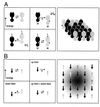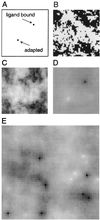Heightened sensitivity of a lattice of membrane receptors
- PMID: 10468569
- PMCID: PMC17849
- DOI: 10.1073/pnas.96.18.10104
Heightened sensitivity of a lattice of membrane receptors
Abstract
Receptor proteins in both eukaryotic and prokaryotic cells have been found to form two-dimensional clusters in the plasma membrane. In this study, we examine the proposition that such clusters might show coordinated responses because of the spread of conformational states from one receptor to its neighbors. A Monte Carlo simulation was developed in which receptors flipped in probabilistic fashion between an active and an inactive state. Conformational energies depended on (i) ligand binding, (ii) a chemical modification of the receptor conferring adaptation, and (iii) the activity of neighboring receptors. Rate constants were based on data from known biological receptors, especially the bacterial Tar receptor, and on theoretical constraints derived from an analogous Ising model. The simulated system showed a greatly enhanced sensitivity to external signals compared with a corresponding set of uncoupled receptors and was operational over a much wider range of ambient concentrations. These and other properties should make a lattice of conformationally coupled receptors ideally suited to act as a "nose" by which a cell can detect and respond to extracellular stimuli.
Figures






References
Publication types
MeSH terms
Substances
LinkOut - more resources
Full Text Sources

